Risk Management Analysis: A Petrochemical Company in Qatar
VerifiedAdded on 2020/05/28
|23
|6123
|56
Report
AI Summary
This report provides a comprehensive analysis of risk management, focusing on its application within a petrochemical company in Qatar. It begins by defining risk and outlining the importance of effective risk management strategies in business operations. The report explores various aspects of risk management, including risk identification, evaluation methods, and assessment techniques, with a specific focus on small businesses. It examines different types of risks, such as business entity risk, human capital risk, and financial risk, along with the drivers of business risk and their impact. Furthermore, the report discusses the Enterprise Risk Management (ERM) framework, detailing its components and objectives. The report also presents a risk severity matrix and concludes with an overview of risk management strategies and their impact on business continuity, offering valuable insights into mitigating potential losses and ensuring business stability.
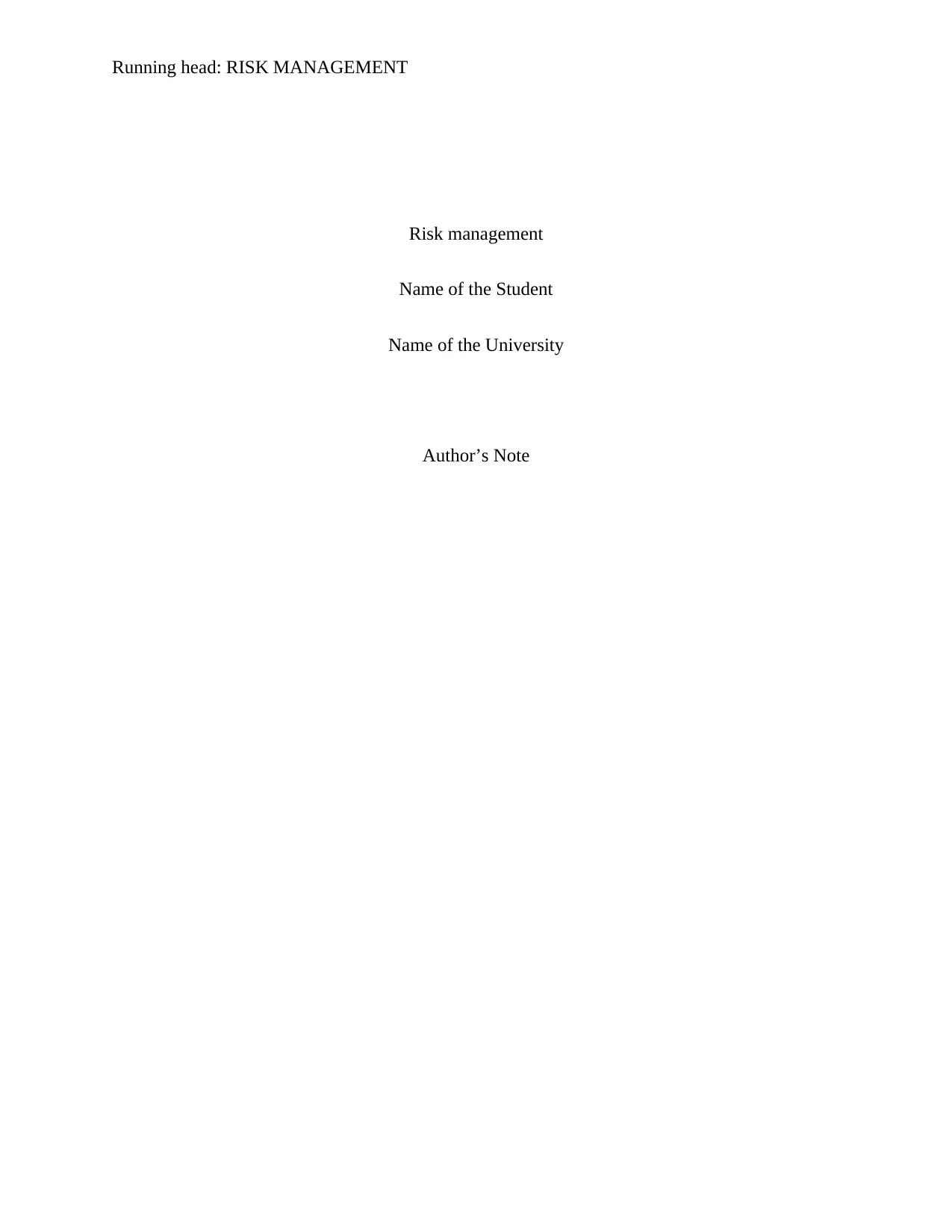
Running head: RISK MANAGEMENT
Risk management
Name of the Student
Name of the University
Author’s Note
Risk management
Name of the Student
Name of the University
Author’s Note
Paraphrase This Document
Need a fresh take? Get an instant paraphrase of this document with our AI Paraphraser
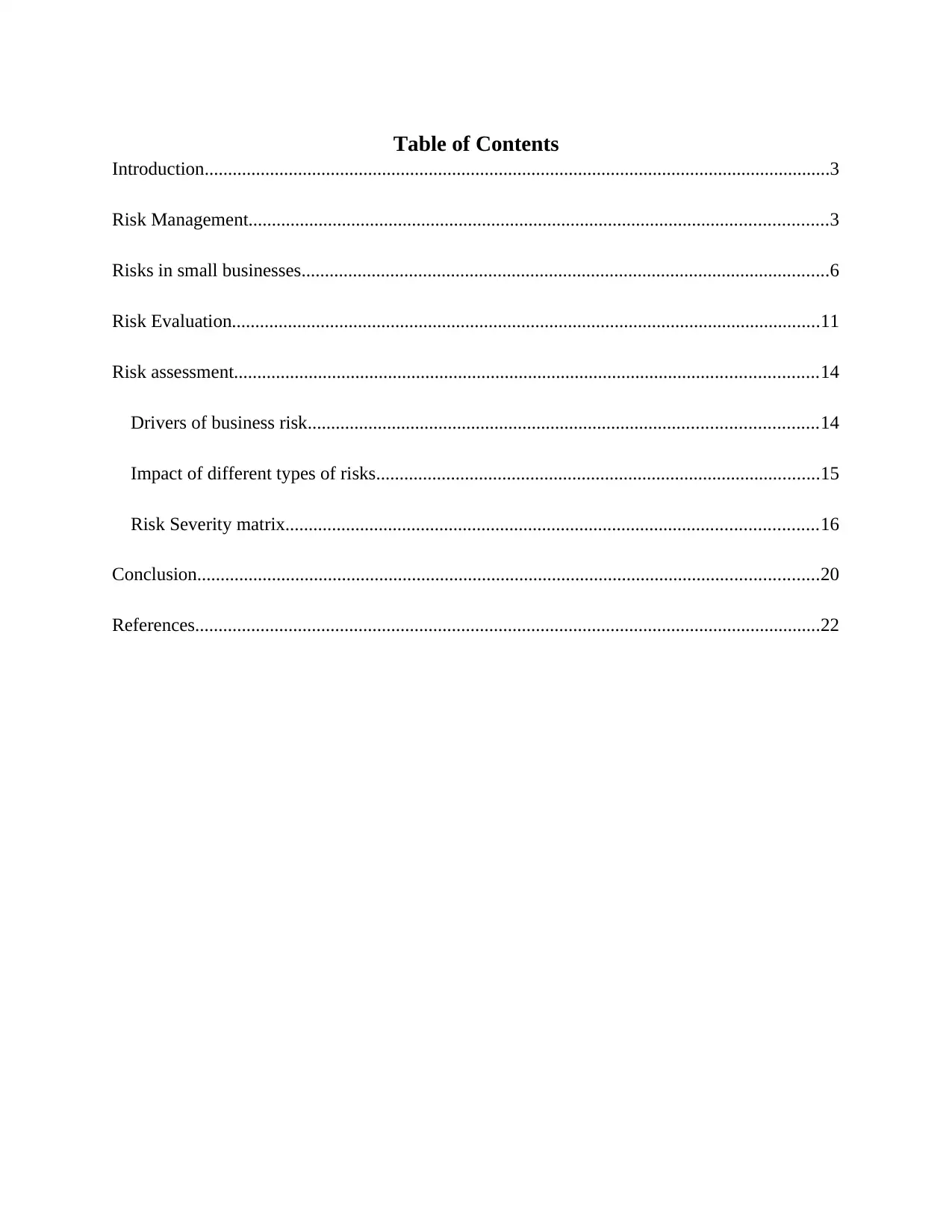
Table of Contents
Introduction......................................................................................................................................3
Risk Management............................................................................................................................3
Risks in small businesses.................................................................................................................6
Risk Evaluation..............................................................................................................................11
Risk assessment.............................................................................................................................14
Drivers of business risk.............................................................................................................14
Impact of different types of risks...............................................................................................15
Risk Severity matrix..................................................................................................................16
Conclusion.....................................................................................................................................20
References......................................................................................................................................22
Introduction......................................................................................................................................3
Risk Management............................................................................................................................3
Risks in small businesses.................................................................................................................6
Risk Evaluation..............................................................................................................................11
Risk assessment.............................................................................................................................14
Drivers of business risk.............................................................................................................14
Impact of different types of risks...............................................................................................15
Risk Severity matrix..................................................................................................................16
Conclusion.....................................................................................................................................20
References......................................................................................................................................22
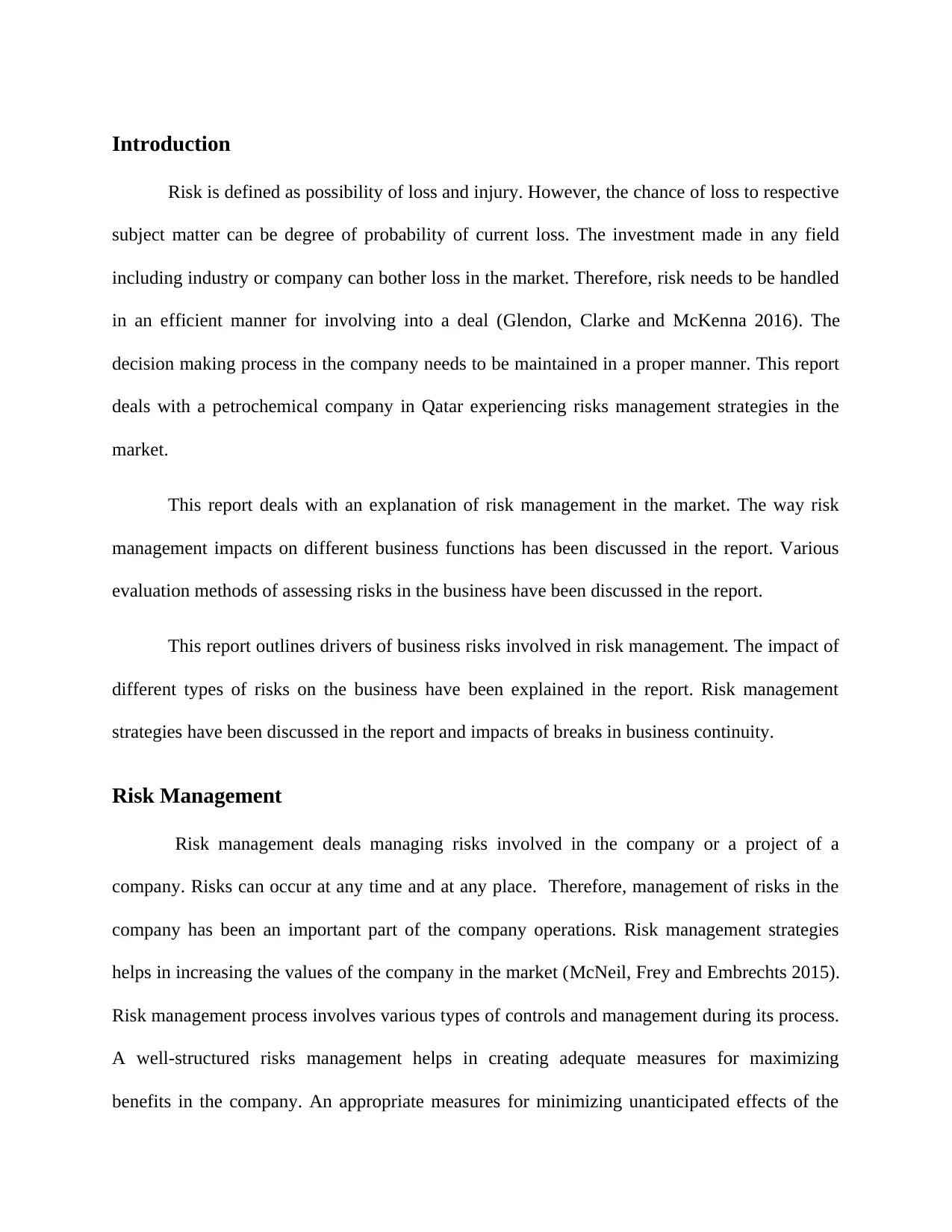
Introduction
Risk is defined as possibility of loss and injury. However, the chance of loss to respective
subject matter can be degree of probability of current loss. The investment made in any field
including industry or company can bother loss in the market. Therefore, risk needs to be handled
in an efficient manner for involving into a deal (Glendon, Clarke and McKenna 2016). The
decision making process in the company needs to be maintained in a proper manner. This report
deals with a petrochemical company in Qatar experiencing risks management strategies in the
market.
This report deals with an explanation of risk management in the market. The way risk
management impacts on different business functions has been discussed in the report. Various
evaluation methods of assessing risks in the business have been discussed in the report.
This report outlines drivers of business risks involved in risk management. The impact of
different types of risks on the business have been explained in the report. Risk management
strategies have been discussed in the report and impacts of breaks in business continuity.
Risk Management
Risk management deals managing risks involved in the company or a project of a
company. Risks can occur at any time and at any place. Therefore, management of risks in the
company has been an important part of the company operations. Risk management strategies
helps in increasing the values of the company in the market (McNeil, Frey and Embrechts 2015).
Risk management process involves various types of controls and management during its process.
A well-structured risks management helps in creating adequate measures for maximizing
benefits in the company. An appropriate measures for minimizing unanticipated effects of the
Risk is defined as possibility of loss and injury. However, the chance of loss to respective
subject matter can be degree of probability of current loss. The investment made in any field
including industry or company can bother loss in the market. Therefore, risk needs to be handled
in an efficient manner for involving into a deal (Glendon, Clarke and McKenna 2016). The
decision making process in the company needs to be maintained in a proper manner. This report
deals with a petrochemical company in Qatar experiencing risks management strategies in the
market.
This report deals with an explanation of risk management in the market. The way risk
management impacts on different business functions has been discussed in the report. Various
evaluation methods of assessing risks in the business have been discussed in the report.
This report outlines drivers of business risks involved in risk management. The impact of
different types of risks on the business have been explained in the report. Risk management
strategies have been discussed in the report and impacts of breaks in business continuity.
Risk Management
Risk management deals managing risks involved in the company or a project of a
company. Risks can occur at any time and at any place. Therefore, management of risks in the
company has been an important part of the company operations. Risk management strategies
helps in increasing the values of the company in the market (McNeil, Frey and Embrechts 2015).
Risk management process involves various types of controls and management during its process.
A well-structured risks management helps in creating adequate measures for maximizing
benefits in the company. An appropriate measures for minimizing unanticipated effects of the
⊘ This is a preview!⊘
Do you want full access?
Subscribe today to unlock all pages.

Trusted by 1+ million students worldwide
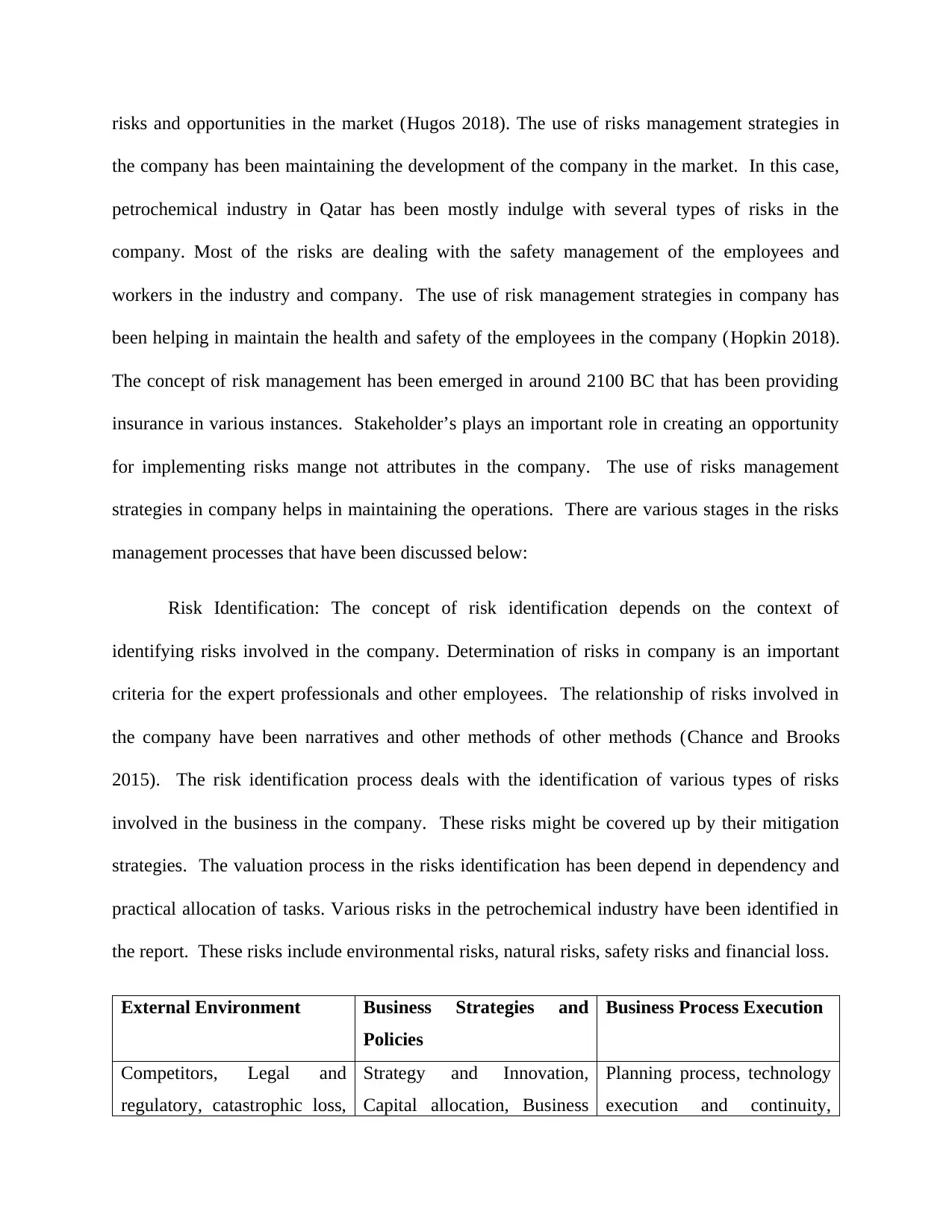
risks and opportunities in the market (Hugos 2018). The use of risks management strategies in
the company has been maintaining the development of the company in the market. In this case,
petrochemical industry in Qatar has been mostly indulge with several types of risks in the
company. Most of the risks are dealing with the safety management of the employees and
workers in the industry and company. The use of risk management strategies in company has
been helping in maintain the health and safety of the employees in the company (Hopkin 2018).
The concept of risk management has been emerged in around 2100 BC that has been providing
insurance in various instances. Stakeholder’s plays an important role in creating an opportunity
for implementing risks mange not attributes in the company. The use of risks management
strategies in company helps in maintaining the operations. There are various stages in the risks
management processes that have been discussed below:
Risk Identification: The concept of risk identification depends on the context of
identifying risks involved in the company. Determination of risks in company is an important
criteria for the expert professionals and other employees. The relationship of risks involved in
the company have been narratives and other methods of other methods (Chance and Brooks
2015). The risk identification process deals with the identification of various types of risks
involved in the business in the company. These risks might be covered up by their mitigation
strategies. The valuation process in the risks identification has been depend in dependency and
practical allocation of tasks. Various risks in the petrochemical industry have been identified in
the report. These risks include environmental risks, natural risks, safety risks and financial loss.
External Environment Business Strategies and
Policies
Business Process Execution
Competitors, Legal and
regulatory, catastrophic loss,
Strategy and Innovation,
Capital allocation, Business
Planning process, technology
execution and continuity,
the company has been maintaining the development of the company in the market. In this case,
petrochemical industry in Qatar has been mostly indulge with several types of risks in the
company. Most of the risks are dealing with the safety management of the employees and
workers in the industry and company. The use of risk management strategies in company has
been helping in maintain the health and safety of the employees in the company (Hopkin 2018).
The concept of risk management has been emerged in around 2100 BC that has been providing
insurance in various instances. Stakeholder’s plays an important role in creating an opportunity
for implementing risks mange not attributes in the company. The use of risks management
strategies in company helps in maintaining the operations. There are various stages in the risks
management processes that have been discussed below:
Risk Identification: The concept of risk identification depends on the context of
identifying risks involved in the company. Determination of risks in company is an important
criteria for the expert professionals and other employees. The relationship of risks involved in
the company have been narratives and other methods of other methods (Chance and Brooks
2015). The risk identification process deals with the identification of various types of risks
involved in the business in the company. These risks might be covered up by their mitigation
strategies. The valuation process in the risks identification has been depend in dependency and
practical allocation of tasks. Various risks in the petrochemical industry have been identified in
the report. These risks include environmental risks, natural risks, safety risks and financial loss.
External Environment Business Strategies and
Policies
Business Process Execution
Competitors, Legal and
regulatory, catastrophic loss,
Strategy and Innovation,
Capital allocation, Business
Planning process, technology
execution and continuity,
Paraphrase This Document
Need a fresh take? Get an instant paraphrase of this document with our AI Paraphraser
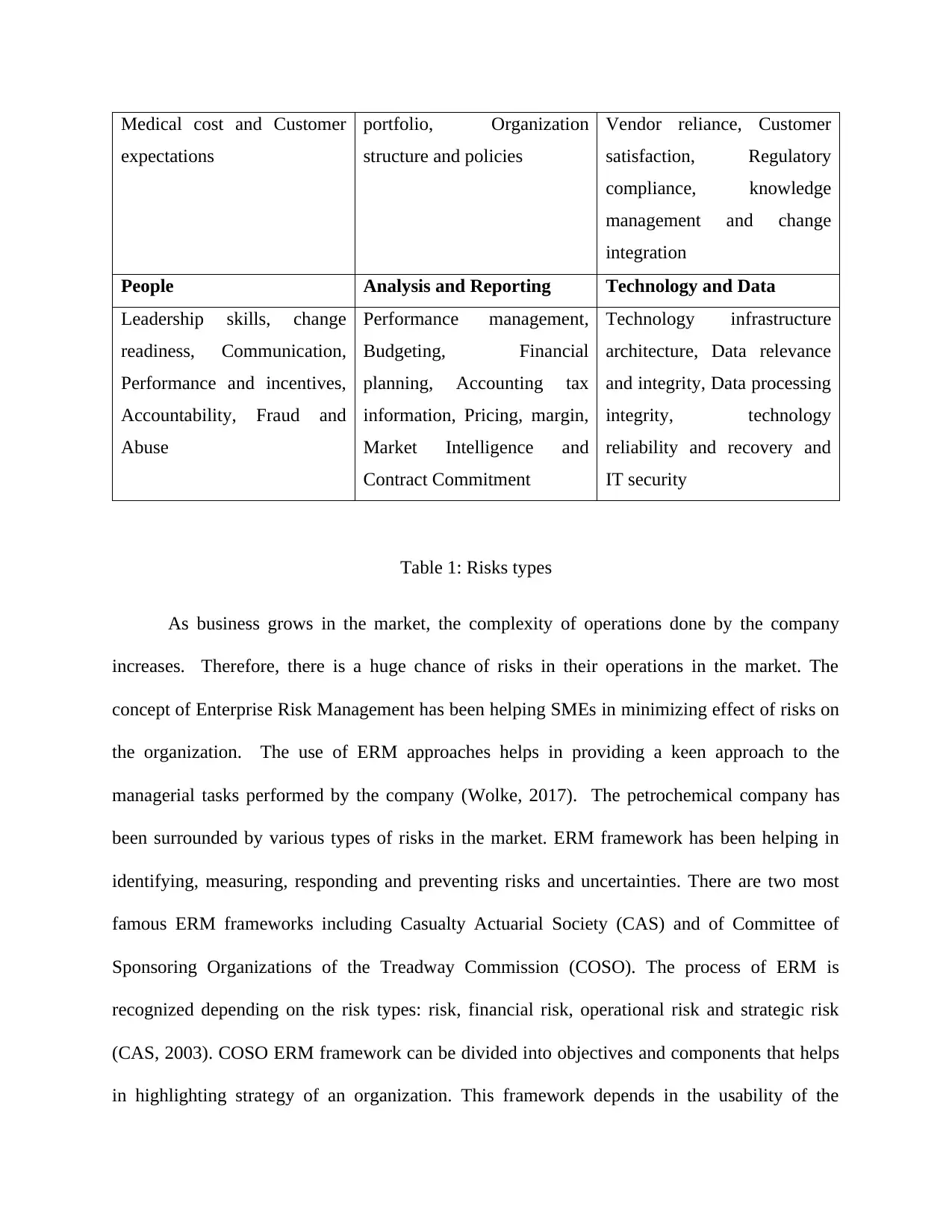
Medical cost and Customer
expectations
portfolio, Organization
structure and policies
Vendor reliance, Customer
satisfaction, Regulatory
compliance, knowledge
management and change
integration
People Analysis and Reporting Technology and Data
Leadership skills, change
readiness, Communication,
Performance and incentives,
Accountability, Fraud and
Abuse
Performance management,
Budgeting, Financial
planning, Accounting tax
information, Pricing, margin,
Market Intelligence and
Contract Commitment
Technology infrastructure
architecture, Data relevance
and integrity, Data processing
integrity, technology
reliability and recovery and
IT security
Table 1: Risks types
As business grows in the market, the complexity of operations done by the company
increases. Therefore, there is a huge chance of risks in their operations in the market. The
concept of Enterprise Risk Management has been helping SMEs in minimizing effect of risks on
the organization. The use of ERM approaches helps in providing a keen approach to the
managerial tasks performed by the company (Wolke, 2017). The petrochemical company has
been surrounded by various types of risks in the market. ERM framework has been helping in
identifying, measuring, responding and preventing risks and uncertainties. There are two most
famous ERM frameworks including Casualty Actuarial Society (CAS) and of Committee of
Sponsoring Organizations of the Treadway Commission (COSO). The process of ERM is
recognized depending on the risk types: risk, financial risk, operational risk and strategic risk
(CAS, 2003). COSO ERM framework can be divided into objectives and components that helps
in highlighting strategy of an organization. This framework depends in the usability of the
expectations
portfolio, Organization
structure and policies
Vendor reliance, Customer
satisfaction, Regulatory
compliance, knowledge
management and change
integration
People Analysis and Reporting Technology and Data
Leadership skills, change
readiness, Communication,
Performance and incentives,
Accountability, Fraud and
Abuse
Performance management,
Budgeting, Financial
planning, Accounting tax
information, Pricing, margin,
Market Intelligence and
Contract Commitment
Technology infrastructure
architecture, Data relevance
and integrity, Data processing
integrity, technology
reliability and recovery and
IT security
Table 1: Risks types
As business grows in the market, the complexity of operations done by the company
increases. Therefore, there is a huge chance of risks in their operations in the market. The
concept of Enterprise Risk Management has been helping SMEs in minimizing effect of risks on
the organization. The use of ERM approaches helps in providing a keen approach to the
managerial tasks performed by the company (Wolke, 2017). The petrochemical company has
been surrounded by various types of risks in the market. ERM framework has been helping in
identifying, measuring, responding and preventing risks and uncertainties. There are two most
famous ERM frameworks including Casualty Actuarial Society (CAS) and of Committee of
Sponsoring Organizations of the Treadway Commission (COSO). The process of ERM is
recognized depending on the risk types: risk, financial risk, operational risk and strategic risk
(CAS, 2003). COSO ERM framework can be divided into objectives and components that helps
in highlighting strategy of an organization. This framework depends in the usability of the
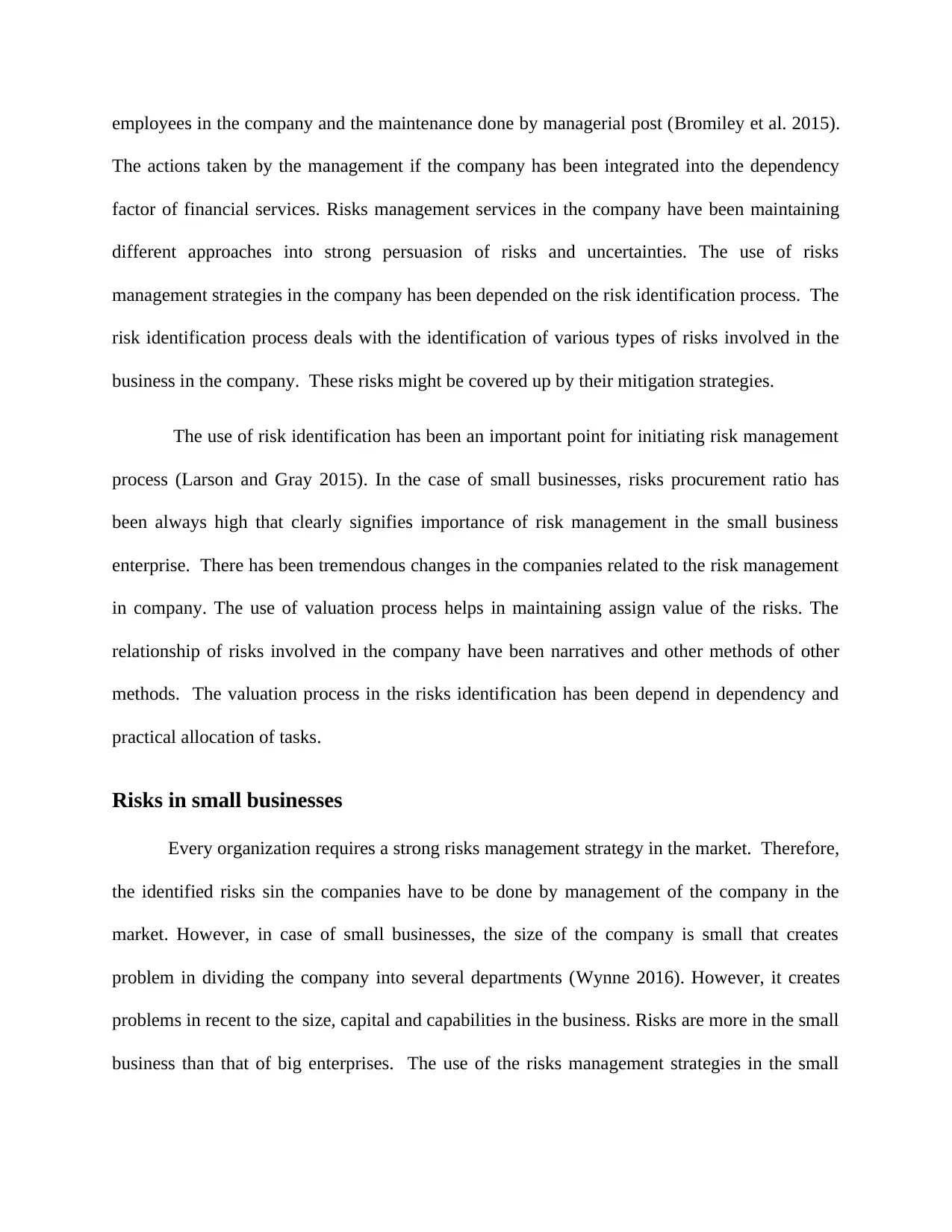
employees in the company and the maintenance done by managerial post (Bromiley et al. 2015).
The actions taken by the management if the company has been integrated into the dependency
factor of financial services. Risks management services in the company have been maintaining
different approaches into strong persuasion of risks and uncertainties. The use of risks
management strategies in the company has been depended on the risk identification process. The
risk identification process deals with the identification of various types of risks involved in the
business in the company. These risks might be covered up by their mitigation strategies.
The use of risk identification has been an important point for initiating risk management
process (Larson and Gray 2015). In the case of small businesses, risks procurement ratio has
been always high that clearly signifies importance of risk management in the small business
enterprise. There has been tremendous changes in the companies related to the risk management
in company. The use of valuation process helps in maintaining assign value of the risks. The
relationship of risks involved in the company have been narratives and other methods of other
methods. The valuation process in the risks identification has been depend in dependency and
practical allocation of tasks.
Risks in small businesses
Every organization requires a strong risks management strategy in the market. Therefore,
the identified risks sin the companies have to be done by management of the company in the
market. However, in case of small businesses, the size of the company is small that creates
problem in dividing the company into several departments (Wynne 2016). However, it creates
problems in recent to the size, capital and capabilities in the business. Risks are more in the small
business than that of big enterprises. The use of the risks management strategies in the small
The actions taken by the management if the company has been integrated into the dependency
factor of financial services. Risks management services in the company have been maintaining
different approaches into strong persuasion of risks and uncertainties. The use of risks
management strategies in the company has been depended on the risk identification process. The
risk identification process deals with the identification of various types of risks involved in the
business in the company. These risks might be covered up by their mitigation strategies.
The use of risk identification has been an important point for initiating risk management
process (Larson and Gray 2015). In the case of small businesses, risks procurement ratio has
been always high that clearly signifies importance of risk management in the small business
enterprise. There has been tremendous changes in the companies related to the risk management
in company. The use of valuation process helps in maintaining assign value of the risks. The
relationship of risks involved in the company have been narratives and other methods of other
methods. The valuation process in the risks identification has been depend in dependency and
practical allocation of tasks.
Risks in small businesses
Every organization requires a strong risks management strategy in the market. Therefore,
the identified risks sin the companies have to be done by management of the company in the
market. However, in case of small businesses, the size of the company is small that creates
problem in dividing the company into several departments (Wynne 2016). However, it creates
problems in recent to the size, capital and capabilities in the business. Risks are more in the small
business than that of big enterprises. The use of the risks management strategies in the small
⊘ This is a preview!⊘
Do you want full access?
Subscribe today to unlock all pages.

Trusted by 1+ million students worldwide
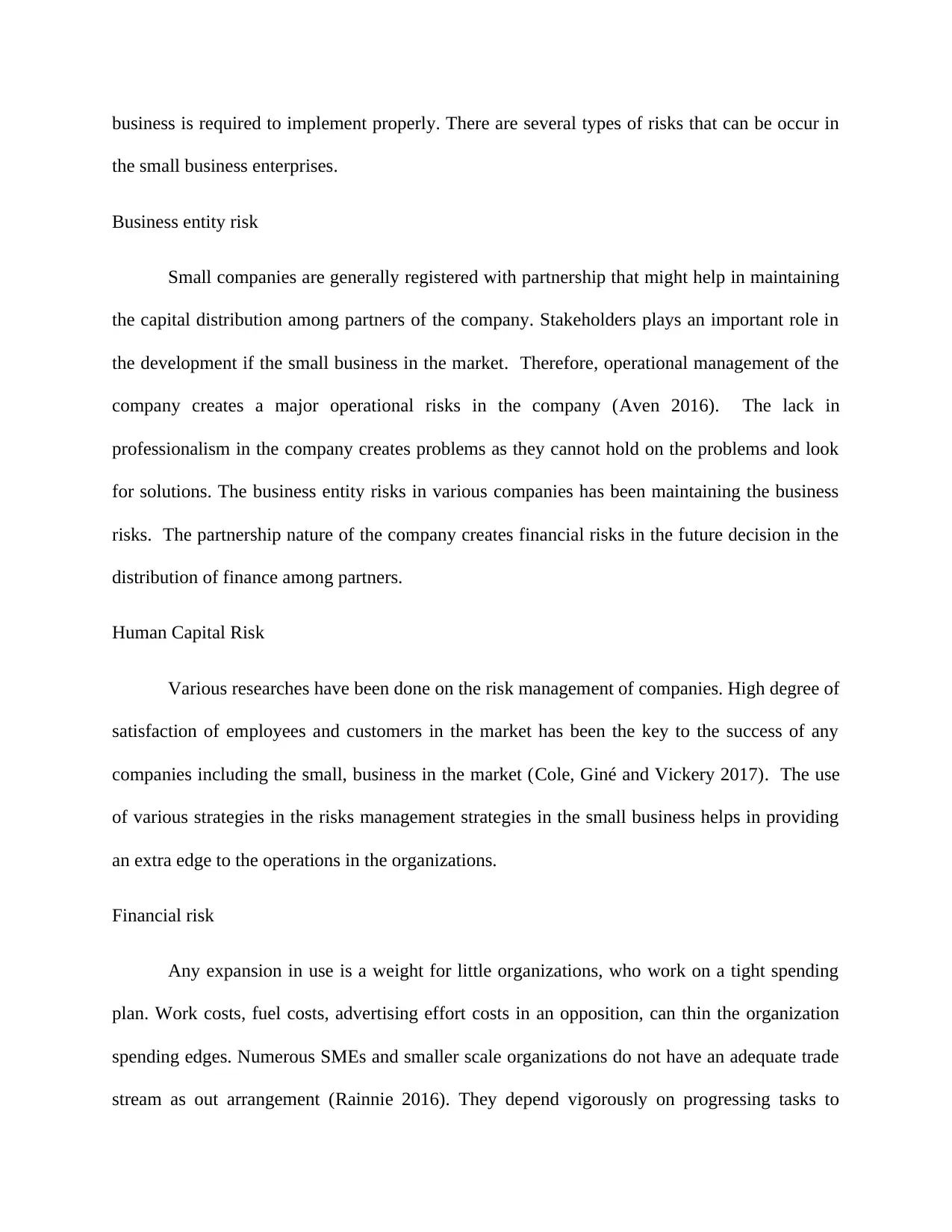
business is required to implement properly. There are several types of risks that can be occur in
the small business enterprises.
Business entity risk
Small companies are generally registered with partnership that might help in maintaining
the capital distribution among partners of the company. Stakeholders plays an important role in
the development if the small business in the market. Therefore, operational management of the
company creates a major operational risks in the company (Aven 2016). The lack in
professionalism in the company creates problems as they cannot hold on the problems and look
for solutions. The business entity risks in various companies has been maintaining the business
risks. The partnership nature of the company creates financial risks in the future decision in the
distribution of finance among partners.
Human Capital Risk
Various researches have been done on the risk management of companies. High degree of
satisfaction of employees and customers in the market has been the key to the success of any
companies including the small, business in the market (Cole, Giné and Vickery 2017). The use
of various strategies in the risks management strategies in the small business helps in providing
an extra edge to the operations in the organizations.
Financial risk
Any expansion in use is a weight for little organizations, who work on a tight spending
plan. Work costs, fuel costs, advertising effort costs in an opposition, can thin the organization
spending edges. Numerous SMEs and smaller scale organizations do not have an adequate trade
stream as out arrangement (Rainnie 2016). They depend vigorously on progressing tasks to
the small business enterprises.
Business entity risk
Small companies are generally registered with partnership that might help in maintaining
the capital distribution among partners of the company. Stakeholders plays an important role in
the development if the small business in the market. Therefore, operational management of the
company creates a major operational risks in the company (Aven 2016). The lack in
professionalism in the company creates problems as they cannot hold on the problems and look
for solutions. The business entity risks in various companies has been maintaining the business
risks. The partnership nature of the company creates financial risks in the future decision in the
distribution of finance among partners.
Human Capital Risk
Various researches have been done on the risk management of companies. High degree of
satisfaction of employees and customers in the market has been the key to the success of any
companies including the small, business in the market (Cole, Giné and Vickery 2017). The use
of various strategies in the risks management strategies in the small business helps in providing
an extra edge to the operations in the organizations.
Financial risk
Any expansion in use is a weight for little organizations, who work on a tight spending
plan. Work costs, fuel costs, advertising effort costs in an opposition, can thin the organization
spending edges. Numerous SMEs and smaller scale organizations do not have an adequate trade
stream as out arrangement (Rainnie 2016). They depend vigorously on progressing tasks to
Paraphrase This Document
Need a fresh take? Get an instant paraphrase of this document with our AI Paraphraser
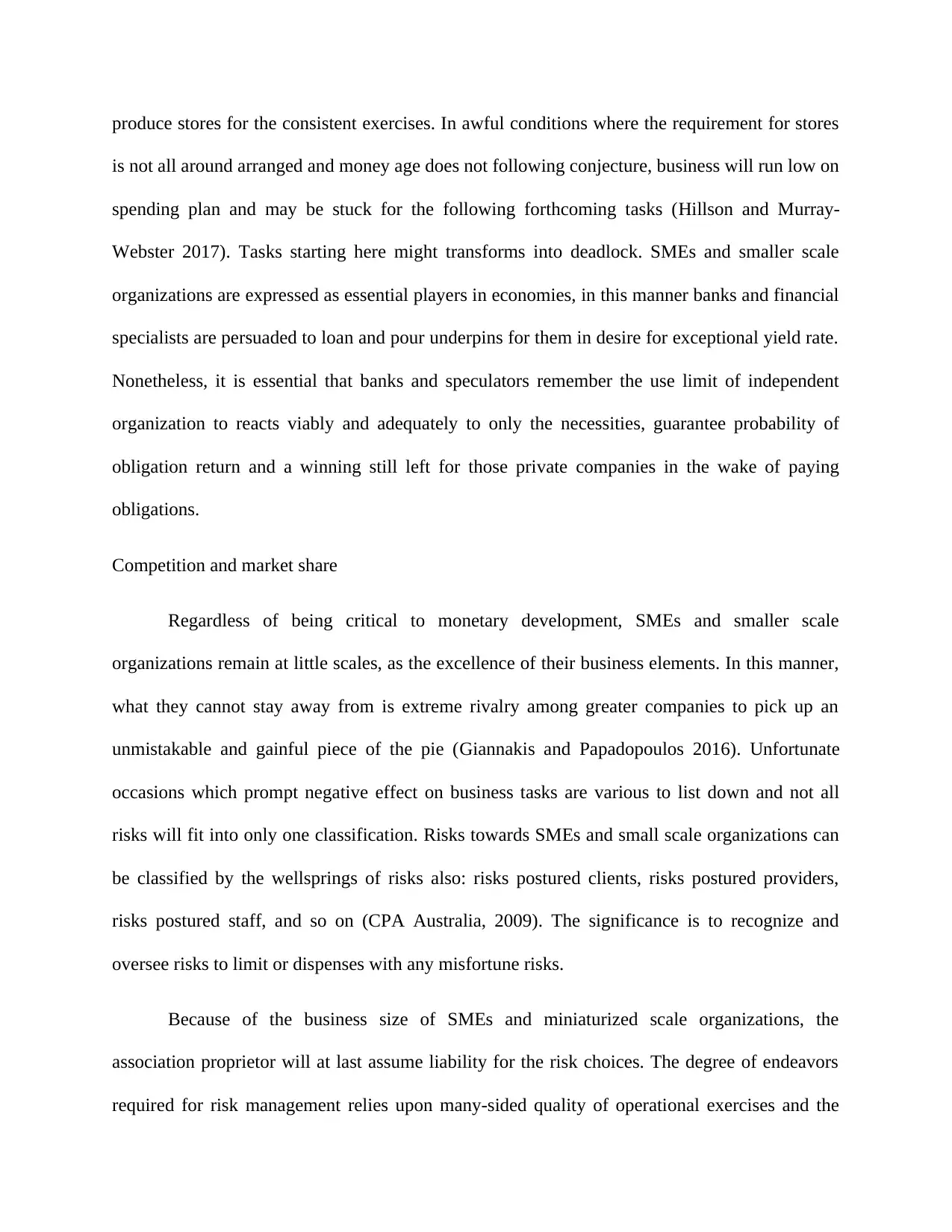
produce stores for the consistent exercises. In awful conditions where the requirement for stores
is not all around arranged and money age does not following conjecture, business will run low on
spending plan and may be stuck for the following forthcoming tasks (Hillson and Murray-
Webster 2017). Tasks starting here might transforms into deadlock. SMEs and smaller scale
organizations are expressed as essential players in economies, in this manner banks and financial
specialists are persuaded to loan and pour underpins for them in desire for exceptional yield rate.
Nonetheless, it is essential that banks and speculators remember the use limit of independent
organization to reacts viably and adequately to only the necessities, guarantee probability of
obligation return and a winning still left for those private companies in the wake of paying
obligations.
Competition and market share
Regardless of being critical to monetary development, SMEs and smaller scale
organizations remain at little scales, as the excellence of their business elements. In this manner,
what they cannot stay away from is extreme rivalry among greater companies to pick up an
unmistakable and gainful piece of the pie (Giannakis and Papadopoulos 2016). Unfortunate
occasions which prompt negative effect on business tasks are various to list down and not all
risks will fit into only one classification. Risks towards SMEs and small scale organizations can
be classified by the wellsprings of risks also: risks postured clients, risks postured providers,
risks postured staff, and so on (CPA Australia, 2009). The significance is to recognize and
oversee risks to limit or dispenses with any misfortune risks.
Because of the business size of SMEs and miniaturized scale organizations, the
association proprietor will at last assume liability for the risk choices. The degree of endeavors
required for risk management relies upon many-sided quality of operational exercises and the
is not all around arranged and money age does not following conjecture, business will run low on
spending plan and may be stuck for the following forthcoming tasks (Hillson and Murray-
Webster 2017). Tasks starting here might transforms into deadlock. SMEs and smaller scale
organizations are expressed as essential players in economies, in this manner banks and financial
specialists are persuaded to loan and pour underpins for them in desire for exceptional yield rate.
Nonetheless, it is essential that banks and speculators remember the use limit of independent
organization to reacts viably and adequately to only the necessities, guarantee probability of
obligation return and a winning still left for those private companies in the wake of paying
obligations.
Competition and market share
Regardless of being critical to monetary development, SMEs and smaller scale
organizations remain at little scales, as the excellence of their business elements. In this manner,
what they cannot stay away from is extreme rivalry among greater companies to pick up an
unmistakable and gainful piece of the pie (Giannakis and Papadopoulos 2016). Unfortunate
occasions which prompt negative effect on business tasks are various to list down and not all
risks will fit into only one classification. Risks towards SMEs and small scale organizations can
be classified by the wellsprings of risks also: risks postured clients, risks postured providers,
risks postured staff, and so on (CPA Australia, 2009). The significance is to recognize and
oversee risks to limit or dispenses with any misfortune risks.
Because of the business size of SMEs and miniaturized scale organizations, the
association proprietor will at last assume liability for the risk choices. The degree of endeavors
required for risk management relies upon many-sided quality of operational exercises and the
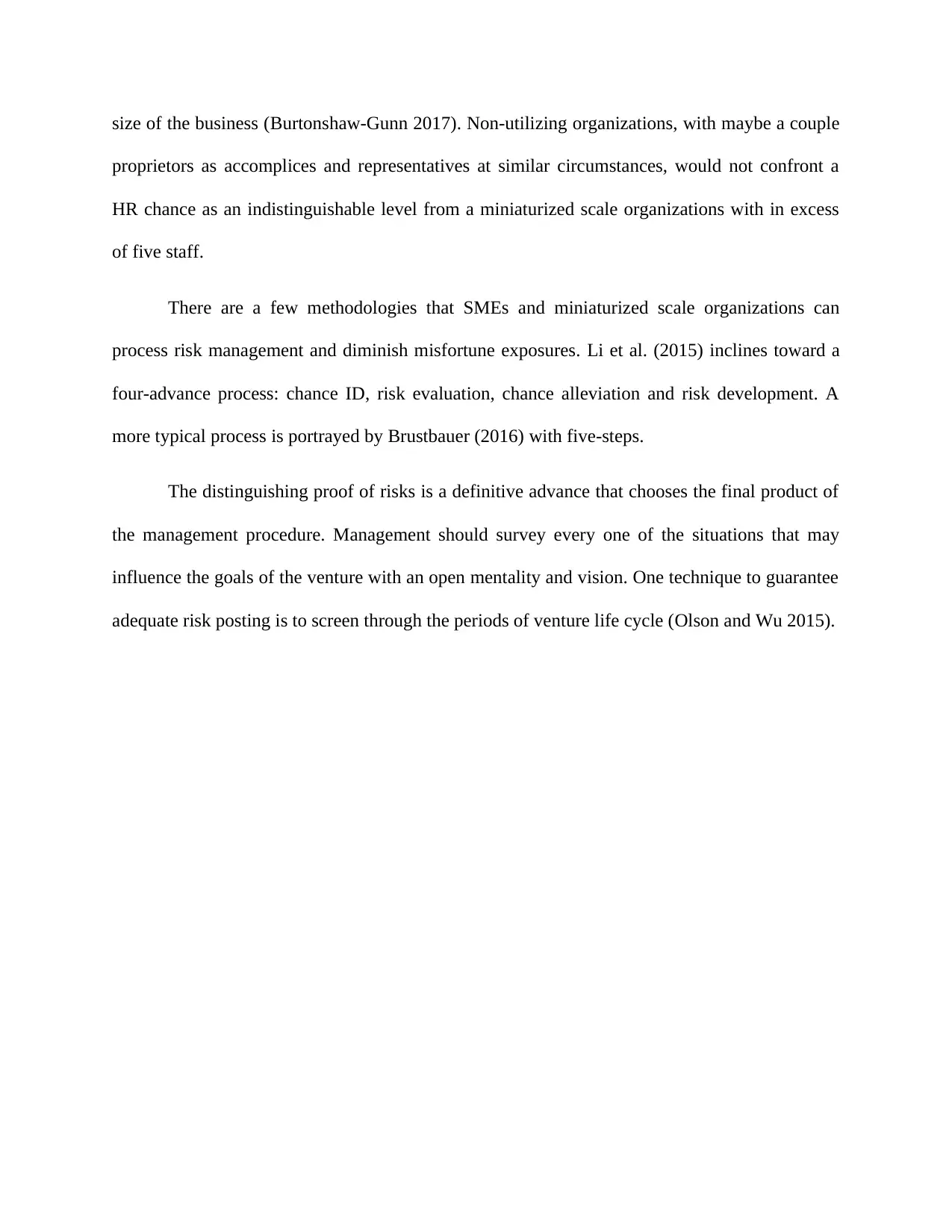
size of the business (Burtonshaw-Gunn 2017). Non-utilizing organizations, with maybe a couple
proprietors as accomplices and representatives at similar circumstances, would not confront a
HR chance as an indistinguishable level from a miniaturized scale organizations with in excess
of five staff.
There are a few methodologies that SMEs and miniaturized scale organizations can
process risk management and diminish misfortune exposures. Li et al. (2015) inclines toward a
four-advance process: chance ID, risk evaluation, chance alleviation and risk development. A
more typical process is portrayed by Brustbauer (2016) with five-steps.
The distinguishing proof of risks is a definitive advance that chooses the final product of
the management procedure. Management should survey every one of the situations that may
influence the goals of the venture with an open mentality and vision. One technique to guarantee
adequate risk posting is to screen through the periods of venture life cycle (Olson and Wu 2015).
proprietors as accomplices and representatives at similar circumstances, would not confront a
HR chance as an indistinguishable level from a miniaturized scale organizations with in excess
of five staff.
There are a few methodologies that SMEs and miniaturized scale organizations can
process risk management and diminish misfortune exposures. Li et al. (2015) inclines toward a
four-advance process: chance ID, risk evaluation, chance alleviation and risk development. A
more typical process is portrayed by Brustbauer (2016) with five-steps.
The distinguishing proof of risks is a definitive advance that chooses the final product of
the management procedure. Management should survey every one of the situations that may
influence the goals of the venture with an open mentality and vision. One technique to guarantee
adequate risk posting is to screen through the periods of venture life cycle (Olson and Wu 2015).
⊘ This is a preview!⊘
Do you want full access?
Subscribe today to unlock all pages.

Trusted by 1+ million students worldwide
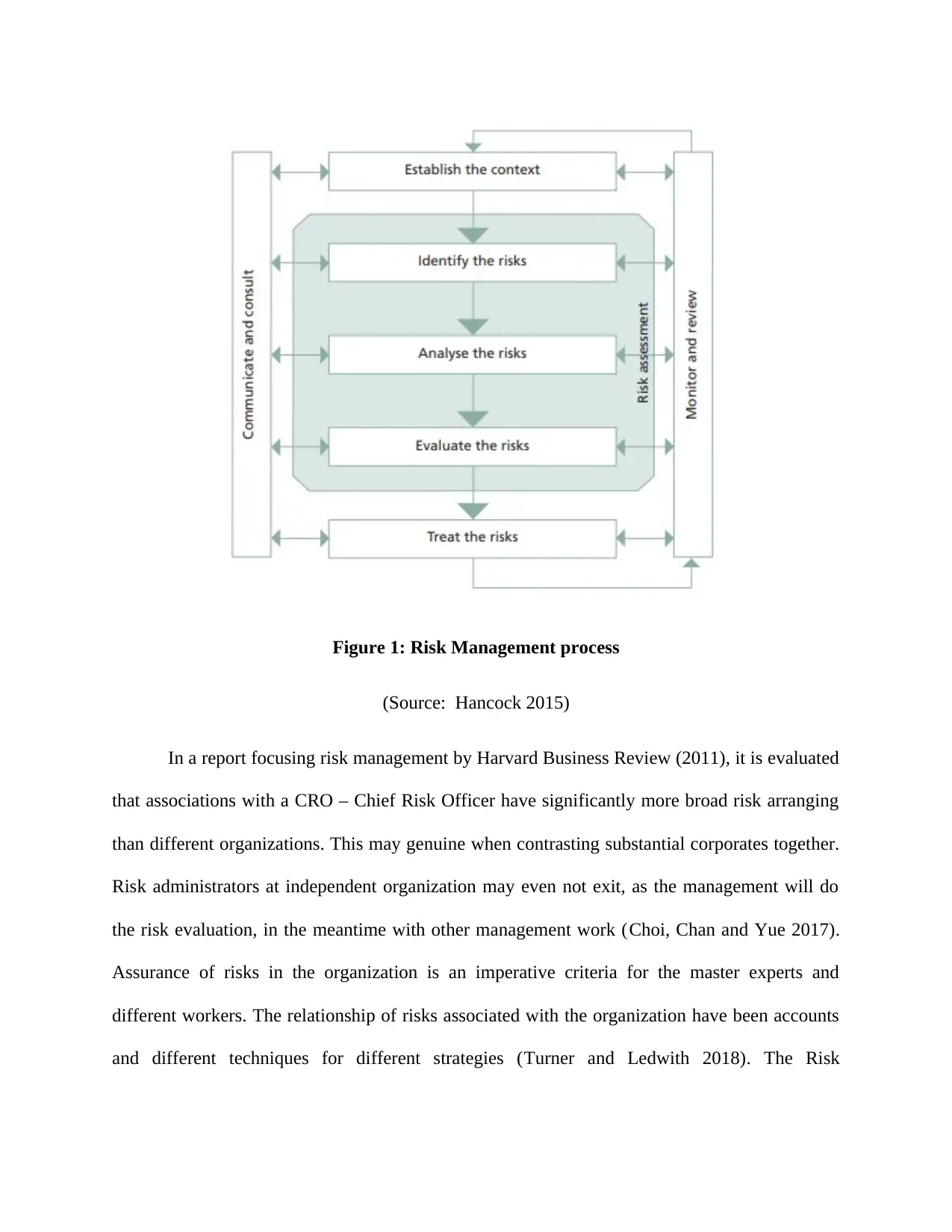
Figure 1: Risk Management process
(Source: Hancock 2015)
In a report focusing risk management by Harvard Business Review (2011), it is evaluated
that associations with a CRO – Chief Risk Officer have significantly more broad risk arranging
than different organizations. This may genuine when contrasting substantial corporates together.
Risk administrators at independent organization may even not exit, as the management will do
the risk evaluation, in the meantime with other management work (Choi, Chan and Yue 2017).
Assurance of risks in the organization is an imperative criteria for the master experts and
different workers. The relationship of risks associated with the organization have been accounts
and different techniques for different strategies (Turner and Ledwith 2018). The Risk
(Source: Hancock 2015)
In a report focusing risk management by Harvard Business Review (2011), it is evaluated
that associations with a CRO – Chief Risk Officer have significantly more broad risk arranging
than different organizations. This may genuine when contrasting substantial corporates together.
Risk administrators at independent organization may even not exit, as the management will do
the risk evaluation, in the meantime with other management work (Choi, Chan and Yue 2017).
Assurance of risks in the organization is an imperative criteria for the master experts and
different workers. The relationship of risks associated with the organization have been accounts
and different techniques for different strategies (Turner and Ledwith 2018). The Risk
Paraphrase This Document
Need a fresh take? Get an instant paraphrase of this document with our AI Paraphraser
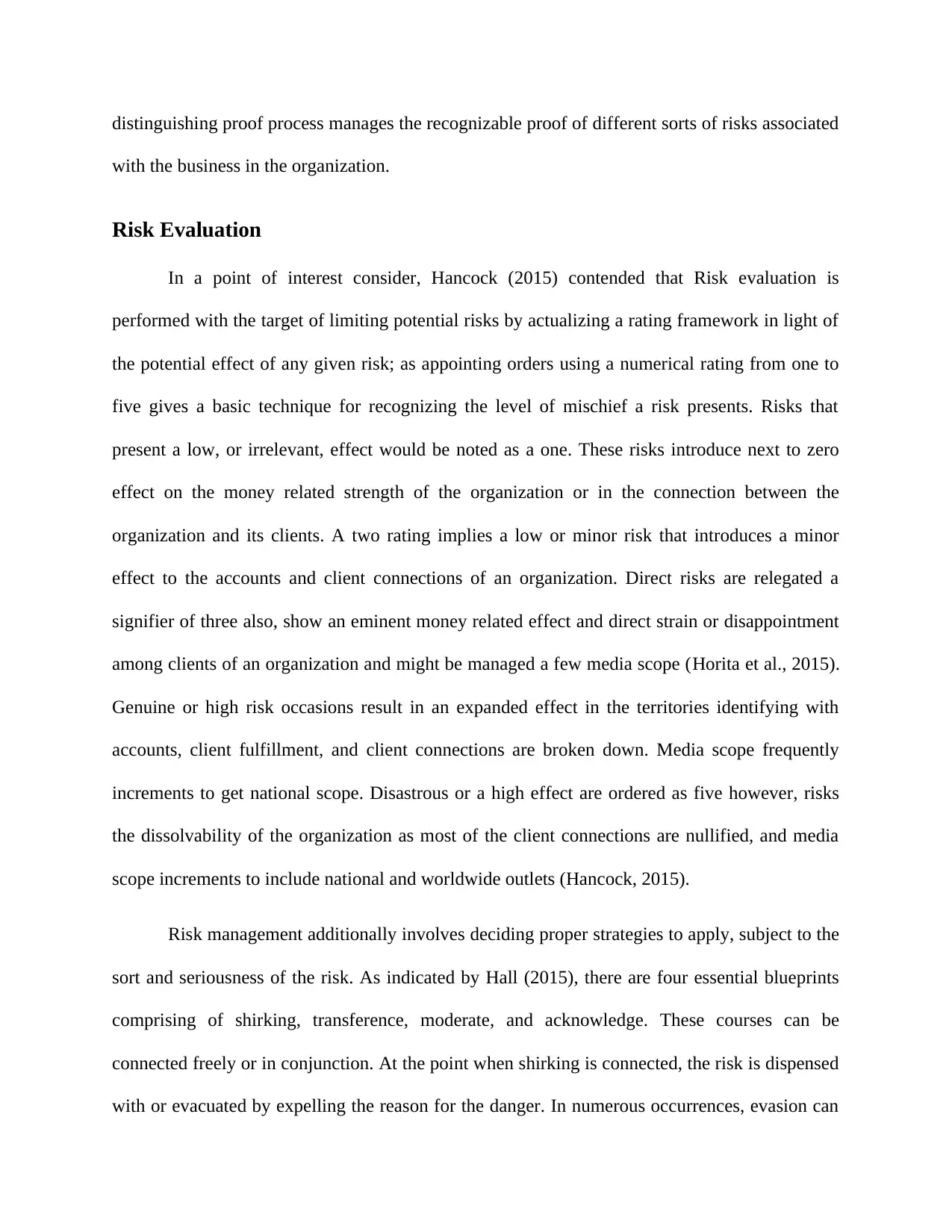
distinguishing proof process manages the recognizable proof of different sorts of risks associated
with the business in the organization.
Risk Evaluation
In a point of interest consider, Hancock (2015) contended that Risk evaluation is
performed with the target of limiting potential risks by actualizing a rating framework in light of
the potential effect of any given risk; as appointing orders using a numerical rating from one to
five gives a basic technique for recognizing the level of mischief a risk presents. Risks that
present a low, or irrelevant, effect would be noted as a one. These risks introduce next to zero
effect on the money related strength of the organization or in the connection between the
organization and its clients. A two rating implies a low or minor risk that introduces a minor
effect to the accounts and client connections of an organization. Direct risks are relegated a
signifier of three also, show an eminent money related effect and direct strain or disappointment
among clients of an organization and might be managed a few media scope (Horita et al., 2015).
Genuine or high risk occasions result in an expanded effect in the territories identifying with
accounts, client fulfillment, and client connections are broken down. Media scope frequently
increments to get national scope. Disastrous or a high effect are ordered as five however, risks
the dissolvability of the organization as most of the client connections are nullified, and media
scope increments to include national and worldwide outlets (Hancock, 2015).
Risk management additionally involves deciding proper strategies to apply, subject to the
sort and seriousness of the risk. As indicated by Hall (2015), there are four essential blueprints
comprising of shirking, transference, moderate, and acknowledge. These courses can be
connected freely or in conjunction. At the point when shirking is connected, the risk is dispensed
with or evacuated by expelling the reason for the danger. In numerous occurrences, evasion can
with the business in the organization.
Risk Evaluation
In a point of interest consider, Hancock (2015) contended that Risk evaluation is
performed with the target of limiting potential risks by actualizing a rating framework in light of
the potential effect of any given risk; as appointing orders using a numerical rating from one to
five gives a basic technique for recognizing the level of mischief a risk presents. Risks that
present a low, or irrelevant, effect would be noted as a one. These risks introduce next to zero
effect on the money related strength of the organization or in the connection between the
organization and its clients. A two rating implies a low or minor risk that introduces a minor
effect to the accounts and client connections of an organization. Direct risks are relegated a
signifier of three also, show an eminent money related effect and direct strain or disappointment
among clients of an organization and might be managed a few media scope (Horita et al., 2015).
Genuine or high risk occasions result in an expanded effect in the territories identifying with
accounts, client fulfillment, and client connections are broken down. Media scope frequently
increments to get national scope. Disastrous or a high effect are ordered as five however, risks
the dissolvability of the organization as most of the client connections are nullified, and media
scope increments to include national and worldwide outlets (Hancock, 2015).
Risk management additionally involves deciding proper strategies to apply, subject to the
sort and seriousness of the risk. As indicated by Hall (2015), there are four essential blueprints
comprising of shirking, transference, moderate, and acknowledge. These courses can be
connected freely or in conjunction. At the point when shirking is connected, the risk is dispensed
with or evacuated by expelling the reason for the danger. In numerous occurrences, evasion can
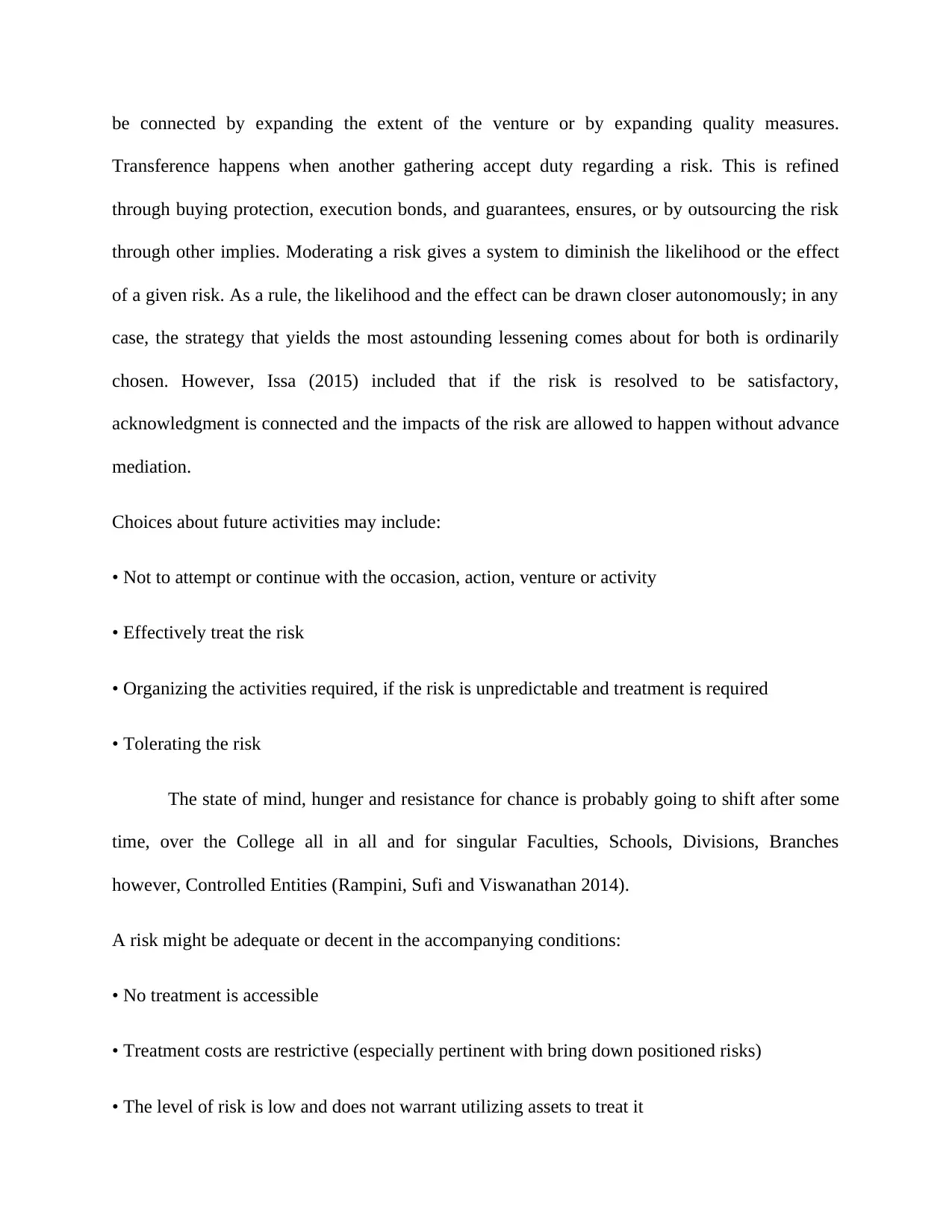
be connected by expanding the extent of the venture or by expanding quality measures.
Transference happens when another gathering accept duty regarding a risk. This is refined
through buying protection, execution bonds, and guarantees, ensures, or by outsourcing the risk
through other implies. Moderating a risk gives a system to diminish the likelihood or the effect
of a given risk. As a rule, the likelihood and the effect can be drawn closer autonomously; in any
case, the strategy that yields the most astounding lessening comes about for both is ordinarily
chosen. However, Issa (2015) included that if the risk is resolved to be satisfactory,
acknowledgment is connected and the impacts of the risk are allowed to happen without advance
mediation.
Choices about future activities may include:
• Not to attempt or continue with the occasion, action, venture or activity
• Effectively treat the risk
• Organizing the activities required, if the risk is unpredictable and treatment is required
• Tolerating the risk
The state of mind, hunger and resistance for chance is probably going to shift after some
time, over the College all in all and for singular Faculties, Schools, Divisions, Branches
however, Controlled Entities (Rampini, Sufi and Viswanathan 2014).
A risk might be adequate or decent in the accompanying conditions:
• No treatment is accessible
• Treatment costs are restrictive (especially pertinent with bring down positioned risks)
• The level of risk is low and does not warrant utilizing assets to treat it
Transference happens when another gathering accept duty regarding a risk. This is refined
through buying protection, execution bonds, and guarantees, ensures, or by outsourcing the risk
through other implies. Moderating a risk gives a system to diminish the likelihood or the effect
of a given risk. As a rule, the likelihood and the effect can be drawn closer autonomously; in any
case, the strategy that yields the most astounding lessening comes about for both is ordinarily
chosen. However, Issa (2015) included that if the risk is resolved to be satisfactory,
acknowledgment is connected and the impacts of the risk are allowed to happen without advance
mediation.
Choices about future activities may include:
• Not to attempt or continue with the occasion, action, venture or activity
• Effectively treat the risk
• Organizing the activities required, if the risk is unpredictable and treatment is required
• Tolerating the risk
The state of mind, hunger and resistance for chance is probably going to shift after some
time, over the College all in all and for singular Faculties, Schools, Divisions, Branches
however, Controlled Entities (Rampini, Sufi and Viswanathan 2014).
A risk might be adequate or decent in the accompanying conditions:
• No treatment is accessible
• Treatment costs are restrictive (especially pertinent with bring down positioned risks)
• The level of risk is low and does not warrant utilizing assets to treat it
⊘ This is a preview!⊘
Do you want full access?
Subscribe today to unlock all pages.

Trusted by 1+ million students worldwide
1 out of 23
Related Documents
Your All-in-One AI-Powered Toolkit for Academic Success.
+13062052269
info@desklib.com
Available 24*7 on WhatsApp / Email
![[object Object]](/_next/static/media/star-bottom.7253800d.svg)
Unlock your academic potential
Copyright © 2020–2025 A2Z Services. All Rights Reserved. Developed and managed by ZUCOL.




